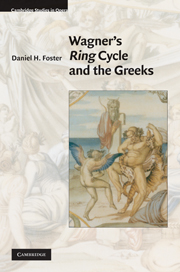Book contents
- Frontmatter
- Contents
- List of musical examples
- Preface
- Acknowledgments
- Introduction
- Part I Epic
- Part II Lyric
- 5 Introduction: what is lyric?
- 6 Orpheus and lyric liberation
- 7 First-person opera and lyric identity
- 8 Lyric and the rebirth of tragedy
- Part III Drama
- Epilogue: Time, the Ring, and Performance Studies
- Appendices: Wagner's primary and secondary sources
- Notes
- Bibliography
- Index
6 - Orpheus and lyric liberation
from Part II - Lyric
Published online by Cambridge University Press: 07 May 2010
- Frontmatter
- Contents
- List of musical examples
- Preface
- Acknowledgments
- Introduction
- Part I Epic
- Part II Lyric
- 5 Introduction: what is lyric?
- 6 Orpheus and lyric liberation
- 7 First-person opera and lyric identity
- 8 Lyric and the rebirth of tragedy
- Part III Drama
- Epilogue: Time, the Ring, and Performance Studies
- Appendices: Wagner's primary and secondary sources
- Notes
- Bibliography
- Index
Summary
Since opera's conception in Renaissance Italy, scholars and composers alike have been asking what can be gained by thinking of drama as its primary model, medium, and literary paradigm. But both in the distant and the more recent past few thinkers have ventured to wonder what opera might gain through its use of lyric. In fact, the most famous formers and reformers of opera have, sometimes quite vociferously, tried to extirpate lyric from opera. Richard Wagner was perhaps the loudest. Looking back at the birth of opera as already a dramatic failure in need of lyrical pruning, Wagner saw the Italian effort to create opera by reviving Greek tragedy as little more than the grafting of church music onto Senecan drama: “Italian Opera is the singular miscarriage of an academic fad, according to which, if one took a versified dialogue modeled more or less on Seneca, and simply got it psalm-sung as one does with the Church-litanies, it was believed one would find oneself on the high road to restoring Antique Tragedy, provided one also arranged for due interruption by choral chants and ballet-dances.” It was such lyrical displays as these “choral chants and ballet-dances” that Wagner sought to root out of opera, while simultaneously raising dialogue, hitherto relegated to the mutterings of recitative, to a higher level of musical sophistication and complexity.
- Type
- Chapter
- Information
- Wagner's Ring Cycle and the Greeks , pp. 122 - 139Publisher: Cambridge University PressPrint publication year: 2010

